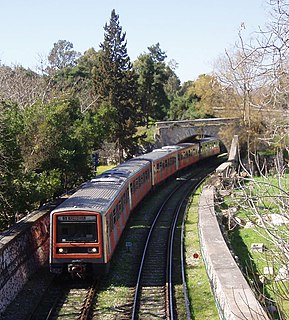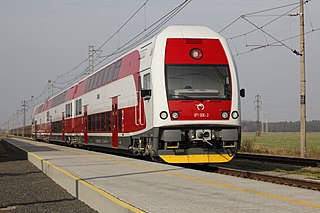This article provides an overview of the transportation infrastructure in the country of Austria.
This article provides an overview of the transportation infrastructure in the country of Austria.
total: 6,123 km (3,523 km electrified)
standard gauge: 5,639 km 1,435 mm (4 ft 8+1⁄2 in) gauge (3,429 km electrified).
narrow gauge: 507 km (23 km 1,000 mm (3 ft 3+3⁄8 in) gauge, 13 km 600 mm (1 ft 11+5⁄8 in) gauge, 468 km 760 mm (2 ft 5+15⁄16 in) gauge - 94 km electrified, and 3 km 600 mm (1 ft 11+5⁄8 in) gauge).
The national railway system of Austria is the Österreichische Bundesbahnen, or ÖBB.
total: 200,000 km (100% paved, including 1700 km of expressways)
358 km, mainly along the Danube
All ports access the Danube.
All Austrian ports are via the Rhine-Main-Danube Canal also connected to the port of Rotterdam in the Netherlands.
Austria has 55 airports and two heliport. Most airports in the country have short, unpaved runways. One airport has paved runways longer than 10,000 feet.
| Length (meters) | Length (feet) | Total No. Airports | Paved (No. Airports) | Unpaved (No. Airports) |
| over 3,043 | over 10,000 | 1 | 1 | 0 |
| 2,438 to 3,043 | 8,000 to 10,000 | 5 | 5 | 0 |
| 1,524 to 2,438 | 5,000 to 8,000 | 2 | 1 | 1 |
| 914 to 1,524 | 3,000 to 5,000 | 6 | 3 | 3 |
| under 914 | under 3,000 | 41 | 15 | 26 |
| totals | totals | 55 | 25 | 30 |

Bosnia and Herzegovina has facilities for road, rail and air transport. There are five international road routes and 20 state highways, with bus connections to many countries. Railways total just over 1,000 km with links to Croatia and Serbia. There are 25 airports, seven of them with paved runways. The Sava River is navigable, but its use is limited.

Transport in Greece have undergone significant changes in the past two decades, vastly modernizing the country's infrastructure and transportation. Although ferry transport between islands remains the prominent method of transport between the nation's islands, improvements to the road infrastructure, rail, urban transport, and airports have all led to a vast improvement in transportation. These upgrades have played a key role in supporting Greece's economy, which in the past decade has come to rely heavily on the construction industry.

Transport in Guinea is composed by a variety of systems that people in the country use to get around as well as to and from domestic and international destinations. The railway from Conakry to Kankan ceased operating in the mid-1980s. Most vehicles in Guinea are 20+ years old, and cabs are any four-door vehicle which the owner has designated as being for hire. Domestic air services are intermittent. Conakry International Airport is the largest airport in the country, with flights to other cities in Africa as well as to Europe.
Transport in Hungary relies on several main modes, including transport by road, rail, air and water.
Transport in Iraq consists of railways, highways, waterways, pipelines, ports and harbors, marines and airports.

Transport in Kenya refers to the transportation structure in Kenya. The country has an extensive network of paved and unpaved roads.
This article provides an overview of the transport infrastructure of Latvia.
Transport in Lithuania relies mainly on road and rail networks.

Transportation in Malawi is poorly developed. The country of almost 14 million has 39 airports, 6 with paved runways and 33 with unpaved runways. It has 797 kilometres of railways, all narrow-gauge and about 45 percent of its roads are paved. Though it is landlocked, Malawi also has 700 km (435 mi) of waterways on Lake Malawi and along the Shire River.
In 1995, the main means of transportation in Moldova were railways and a highway system. The major railway junctions are Chișinău, Bender, Ungheni, Ocnița, Bălți, and Basarabeasca. Primary external rail links connect the republic's network with Odessa on the Black Sea and with the Romanian cities of Iași and Galați; they also lead northward into Ukraine. Highways link Moldova's main cities and provide the chief means of transportation within the country, but roads are in poor repair. The country's major airport is in Chișinău.
Transport in Poland involves air, water, road and rail transportation. The country has a large network of municipal public transport, such as buses, trams and the metro. As a country located at the 'cross-roads' of Europe, Poland, with its highly developed economy, is a nation with a large and increasingly modern network of transport infrastructure.
This article describes the transport in Peru.

There are a number of systems of transport in Sierra Leone, a country in West Africa, which possess road, rail, air and water infrastructure, including a network of highways and several airports.

Transport in Slovakia is possible by rail, road, air or rivers. Slovakia is a developed Central European country with a well-developed rail network (3,662 km) and a highway system. Main international airport is the M. R. Štefánik Airport in the capital, Bratislava. Most important waterway is the river Danube used both by passenger, cargo and freight ships. The two most important harbours in Slovakia is Komarno harbour and Bratislava harbour.

Transport in Ukraine includes ground transportation, water, air transportation, and pipelines. The transportation sector accounts for roughly 11% of the country's gross domestic product and 7% of total employment.
The transport network in Uruguay consists of 1,673 km of rail network, 7,743 km of paved roads, 1,600 km of navigable waterways, and 11 airports with paved roads.
Transport in Serbia includes transport by road, rail, air and water. Road transport incorporates a comprehensive network of major and minor roads. Rail transport is fairly developed, although dual track and electrification are not very common. Water transport revolves around river transport while air transport around country's tree main international airports.

Iran has a long paved road system linking most of its towns and all of its cities. In 2011 the country had 173,000 kilometres (107,000 mi) of roads, of which 73% were paved. In 2008 there were nearly 100 passenger cars for every 1,000 inhabitants.

The first railway in Austria was the narrow-gauge line from Gmunden in the Salzkammergut to Budweis, now in the Czech Republic, this was 1,106 mm gauge. Some two dozen lines were built in 760 mm gauge, a few in 1,000 mmmetre gauge gauge. The first was the Steyrtalbahn. Others were built by provincial governments, some lines are still in common carrier use and a number of others are preservation projects. The tramway network in Innsbruck is also metre gauge; in Linz the rather unusual gauge of 900 mm is in use.

Trams in Linz is a network of tramways forming the backbone of the urban public transport system in Linz, which is the capital city of the federal state of Upper Austria in Austria.
![]() This article incorporates public domain material from World Factbook (2022 ed.). CIA. (Archived 2000 edition)
This article incorporates public domain material from World Factbook (2022 ed.). CIA. (Archived 2000 edition)